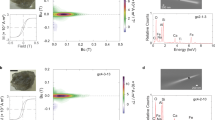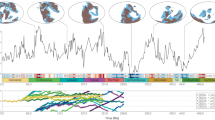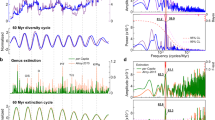Abstract
PANNELLA1,2 and others3,4 have presented palaeontological counts of the number of days per solar year (N) and per synodic month (n) during geologic time. This method is based on the cyclic growth increments of various fossils and has been confirmed in their modern counterparts1,5. The observations extend back to 1.7 × 109 yr with some incomplete data to 2.8 × 109 yr.
This is a preview of subscription content, access via your institution
Access options
Subscribe to this journal
Receive 51 print issues and online access
$199.00 per year
only $3.90 per issue
Buy this article
- Purchase on SpringerLink
- Instant access to full article PDF
Prices may be subject to local taxes which are calculated during checkout
Similar content being viewed by others
References
Pannella, G., Astrophys. Space Sci., 16, 212 (1972).
Pannella, G., MacClintock, C., and Thompson, M. N., Science, 162, 792 (1968).
Mazzullo, S. J., Geol. Soc. Amer. Bull., 82, 1085 (1971).
Berry, W. B. N., and Barker, R. M., Nature, 217, 938 (1968).
Clarke, G. R., Science, 161, 800 (1968).
Fairbridge, R. W., Ann. NY Acad. Sci., 187, 88 (1972).
Runcorn, S. K., Nature, 204, 823 (1964).
Anon., New Scientist, 56, 439 (1972).
Munk, W. H., and Macdonald, G. J. F., The Rotation of the Earth, 201 (Cambridge, London, 1960).
Newton, R. R., Geophys. J. Roy. Astron. Soc., 14, 505 (1968).
Hipkin, R. G., in Paleogeophysics (edit. by Runcorn, S. K.), 54 (Academic, New York, 1970).
Morrison, L. V., Nature, 241, 519 (1973).
Dirac, P. A. M., Proc. Roy. Soc., A, 165, 199 (1938).
Creer, K. M., in International Dictionary of Geophysics (edit. by Runcorn, S. K.), 388 (Pergamon, New York, 1967).
Runcorn, S. K., in The Earth-Moon System (edit. by Marsden, B. G., and Cameron, A. G. W.), 82 (Plenum, New York, 1966).
Runcorn, S. K., in The Application of Modern Physics to the Earth and Planetary Interiors (edit. by Runcorn, S. K.), 47 (Interscience, 1969).
Lyttleton, R. A., Proc. Roy. Soc., A, 275, 1 (1963).
Urey, H. C., The Planets (Yale Univ., New Haven, 1952).
Runcorn, S. K., Phil. Trans. Roy. Soc., A, 258, 228 (1965).
Egyed, L., Nature, 178, 534 (1956).
Creer, K. M., Nature, 205, 539 (1965).
Author information
Authors and Affiliations
Rights and permissions
About this article
Cite this article
WEINSTEIN, D., KEENEY, J. Apparent Loss of Angular Momentum in the Earth–Moon System. Nature 244, 83–84 (1973). https://doi.org/10.1038/244083a0
Received:
Revised:
Published:
Issue date:
DOI: https://doi.org/10.1038/244083a0
This article is cited by
-
Generalisation of Hubble's Law
Nature (1974)



